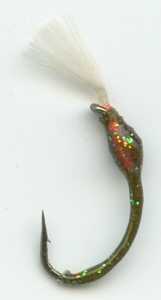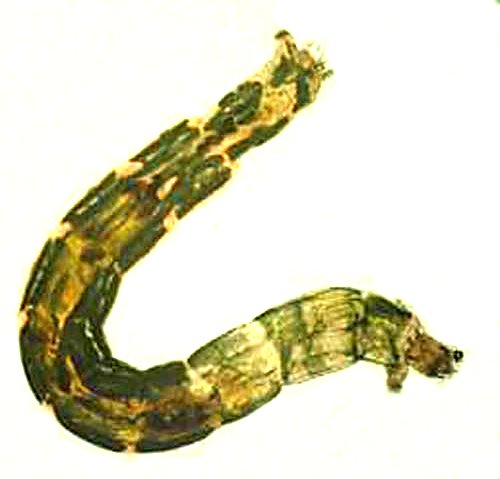Olive Epoxy Buzzer Midge Nymph
The olive epoxy buzzer midge nymph fly imitates the tiny Chironomid flies that inhabit lakes and slow-flowing rivers that are eaten by grayling and trout.

EPOXY BUZZER MIDGE FLY PATTERNS. Hook size 14 12 - $US each
In lakes, reservoirs and slow moving water you will find midge larvae. They form a staple diet for grayling, rainbow and brown trout throughout the year. Use an olive epoxy buzzer midge fly pattern on a dropper as part of a team of three nymphs tied under a floating strike indicator or buoyant dry fly. Make the heaviest fly the point fly to keep the leader vertical. This olive epoxy buzzer fly pattern can also be used to imitate the crane fly larvae that is often found at the bottom of large lakes and reservoirs.
I like to use a plummet to gauge the depth of the water. Do not buy one. Make one out of a lead weight and a marked line. Once I know how deep the water is I adjust the leader accordingly so that the point fly settles in the correct depth on every cast. If the trout start taking the droppers then this indicates that the fish are moving up away from the bottom to feed. Simply decrease the length of your leader so all you flies are fishing at the correct depth.
If when you are casting the one of the buzzers are intercepted before the point fly has reached its correct depth then this will indicate that the fish have changed the depth at which they are fishing again (normally because of a change in water temperature or the weather). It is time to adjust the length of the leader to catch the fish feeding nearer the surface.

What about the theory that trout are quick to reject flies with a hard fell to them I hear some of you saying? Any nagging worries disappeared when I first used them on stillwater. I retrieved them extremely slowly, inched back, and these iron hard flies were taken with conviction. Generally black is the most effective color during the early season with olive more effective later on in the season. The buzzers tend to be larger in the warmer months so choose your hook size to match the natural insects. On the river fish a single buzzer nymph upstream using the tip of your fly line to register takes.
For beginners always learn to cast with a single fly tied on and only move on to a multi-fly rig having mastered your own casting technique. To achieve a balanced cast space your droppers evenly. If using flies of similar weight and size I try and space them evenly apart. If using flies of different weight and size I try to grade them with the heaviest on the point (end). Using two weighted flies can cause problems as they start pulling in their own direction causing snagging and problems when casting.
How to fish 'the Bung' with Epoxy Buzzers
Some anglers get hooked on boat fishing on large stillwaters because there is no vegetation to get tangled up in and little walking involved. Others just like playing around in boats. If you are a river fly fisherman you have to learn a few different techniques to succeed.
Last week I took Bob out on a boat on my local large reservoir. He was on a three week fly fishing holiday from Australia. He only fished rivers and from the beach in Oz. Stillwater fishing was a new experience for him.
I decide to introduce him to 'the Bung'. This is a fishing method which some anglers hate and others swear by. It is also known as the 'strike indicator' fishing technique. Love it or hate it, there is no better way of fishing epoxy buzzer nymphs vertically that covers so many different depths of water at the same time in the search for feeding fish.
You can use a commercially available indicator made from foam but I prefer to use a very buoyant highly visible dry fly that has a hook in it. I have had a number of flies take my surface strike indicator. The set-up I used with Bob incorporated four flies.
The buoyant fly is on the top dropper. This is known as the Bung fly. It is followed by three epoxy buzzer nymphs below. The point fly is normally the heaviest. Each dropper line is 2-3 feet in length and the gap between each dropper on the main leader is around 3 1/2 feet. Total length of leader is about 11 feet off a floating line.
To prepare the leader for the bung I showed Bob how to degrease the line using a pinch of mud-type sinkant compound. I get him to degrease the whole length except the first 3 feet from the end of the fly line. Sometimes the leader loop will sink so I will use a floatant such as Gink to grease up both the loop and the top three feet of leader to ensure it stays on top.
Most anglers will only fish the bung method when there is a gentle ripple on the water, but I find it far more effective in a larger wave. If you think about it, it makes sense because the bigger the wave, the more the flies are going to move up and down in the water as the bung, the top dropper fly, bobs on the surface. This makes the artificial flies look more attractive to the trout as they appear to move like the real insects. This movement gives the appearance of life.
The important point I have to drum home to Bob is to leave the rig alone for at least 40 seconds after casting. This lets the flies sink under the bung fly. Only after this time period has elapsed do I let Bob start to retrieve the flies briefly so that they will be lifted up in the water column, before stopping to allow them to sink again.
I explained to Bob that this process is repeated until the flies reach the boat at which point the 'hang' method should be used. You will be surprised at how many fish are caught on that final lift. When you finish your retrieve, WAIT. Lift the rod slowly, watching the line at all times. This gives a following fish plenty of time to take one of your rising flies. If you see any movement, strike.
It is important to properly explain the 'hang' to a beginner as they are normally more concerned with recasting. They miss potential takes because they lift their rod too quickly.
I got Bob to practice the hang once when he had ten feet of line still out of the rod tip ring, repeating this again at five feet and for a third time when the top dropper was just on the surface. This maximised his chance of catching a fish and gives the fish all the time in the world to take the rising slow moving fly.
Bob caught six trout in two hours. He was a very happy Australian fly fishing tourist.




Fly Fishing books

